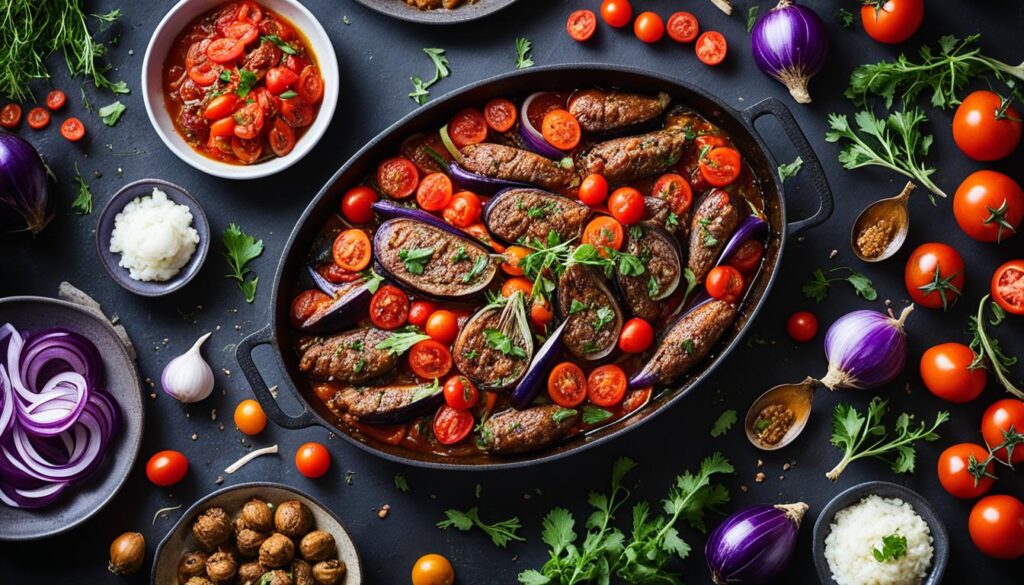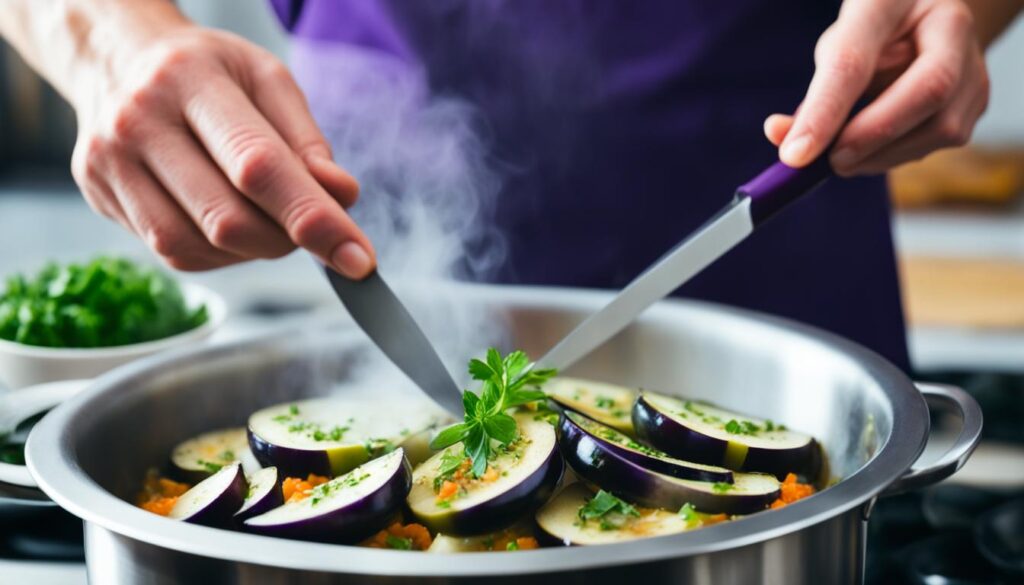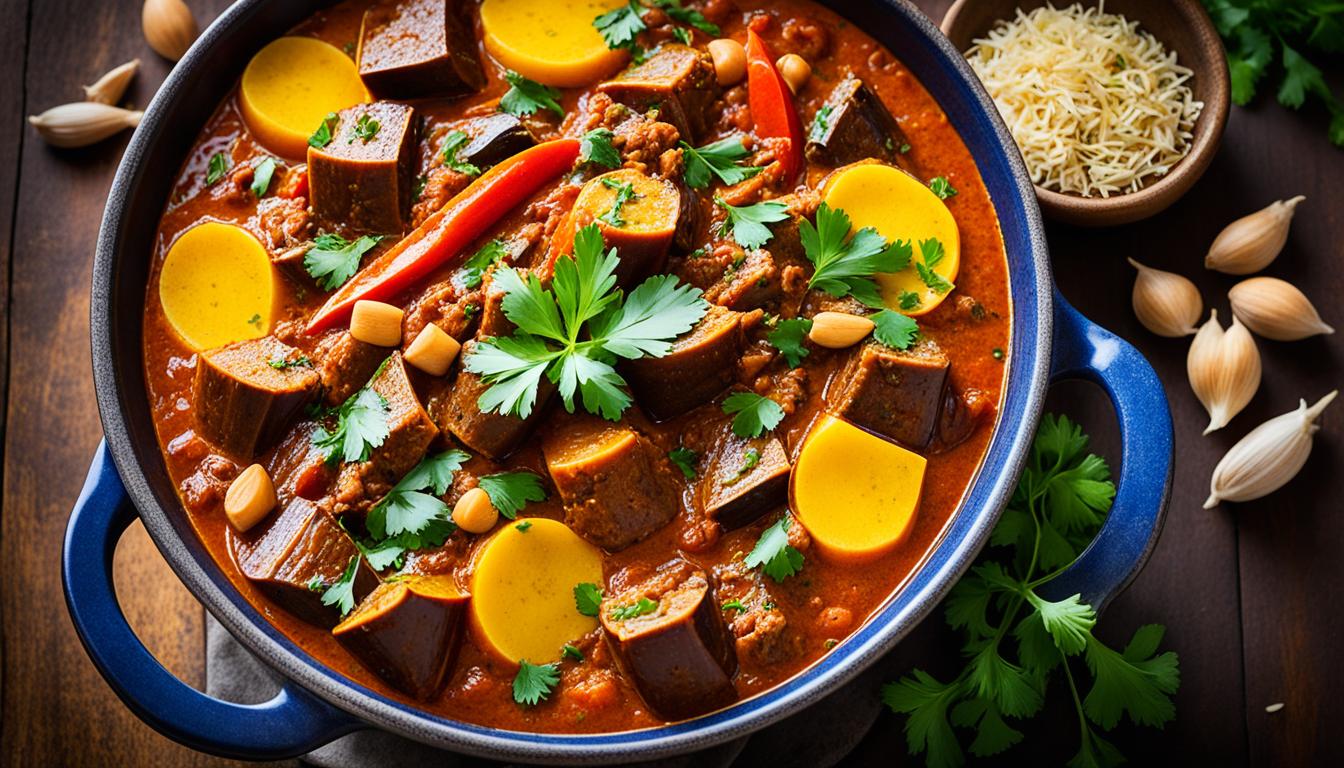Are you ready to embark on a culinary journey to the heart of Iran? Discover the flavors of Persia with our authentic Khoresh e Bademjan recipe. This traditional Persian meat and eggplant stew will transport you to the bustling streets of Tehran, with its rich tomato sauce and tender eggplants simmered to perfection.
At first glance, you might think that this dish is just another eggplant stew, but Khoresh e Bademjan is so much more. It’s a labor of love that showcases the depth of Iranian cuisine and the unique blend of flavors that make it so special. Get ready to tantalize your taste buds and experience the true essence of Persian cooking.
So, what sets Khoresh e Bademjan apart from other stews? How do the flavors come together to create such a distinct dish? Join us as we delve into the history, ingredients, cooking instructions, variations, and tips for making the perfect Khoresh e Bademjan. Get ready to embrace the rich heritage of Persian cuisine and unlock the secrets behind this beloved Iranian dish.
Key Takeaways:
- Discover the rich flavors of Persian cuisine with our authentic Khoresh e Bademjan stew recipe.
- Learn about the history and origins of Khoresh e Bademjan, a traditional Iranian dish.
- Explore the key ingredients that give Khoresh e Bademjan its unique taste and aroma.
- Follow our step-by-step cooking instructions to create a delicious and hearty stew.
- Explore vegetarian variations and tips for making the perfect Khoresh e Bademjan at home.
The History of Khoresh e Bademjan
Khoresh Bademjan is a classic Persian dish that has a long and rich history. This traditional Persian stew, known for its delectable flavors and unique combination of ingredients, has been enjoyed for centuries in Iran.
The origins of khoresh e bademjan can be traced back to ancient Persia, where it was a staple at lavish dinner parties and feasts. The dish reflects the culinary expertise and cultural heritage of the Persian people.
The name “khoresh e bademjan” translates to “stew with eggplant” in English. The eggplant, or “bademjan,” is the star ingredient of this flavorful stew.
“Khoresh Bademjan is a classic Persian dish that has a long and rich history.”
Traditionally, khoresh e bademjan was made with meat, such as lamb or beef, combined with eggplant and a variety of aromatic herbs and spices. The dish was slow-cooked for hours to create a thick and hearty stew.
Over time, different regions and households in Iran developed their own variations of khoresh e bademjan, incorporating local ingredients and flavors. Some versions include the addition of tart ingredients like sour grapes or dried lime, which give the stew a tangy and unique taste.
Today, khoresh e bademjan remains a beloved dish in Persian cuisine and is cherished for its rich history and cultural significance. It continues to be enjoyed by families and shared during festive occasions and gatherings.
Ingredients for Khoresh e Bademjan
When it comes to making a delicious Khoresh e Bademjan, it’s important to have the right ingredients on hand. Here’s what you’ll need:
- Italian eggplants – These eggplants are known for their milder flavor and tender texture, making them perfect for this stew.
- Onion – Adding sweetness and depth to the dish, onions are a fundamental ingredient in Khoresh e Bademjan.
- Garlic – Providing a fragrant aroma and robust flavor, garlic enhances the overall taste of the stew.
- Tomato paste – Thick and concentrated, tomato paste adds a rich tomato flavor to the sauce.
- Tomato passata – This smooth tomato sauce serves as the base for the stew, creating a velvety texture.
- Ground saffron (optional) – For a touch of luxury, ground saffron can be added to infuse the stew with its distinct aroma and vibrant color.
- Canned chickpeas – These legumes provide a hearty protein source and add a nutty flavor to the stew.
- Tomatoes – Fresh tomatoes bring a burst of acidity and bright flavor to the stew.
- Olive oil – Used for sautéing and adding richness, olive oil is a staple in Persian cooking.
- Water – To help create a luscious sauce, water is added to the stew.
- Salt and ground black pepper – These essential seasonings enhance the flavors of the stew, adding depth and balance.
These ingredients come together to create a flavorful and satisfying Khoresh e Bademjan. Feel free to customize the recipe by adding additional spices or herbs that suit your palate. Now that we have our ingredients ready, let’s move on to the cooking instructions!

Ingredients for Khoresh e Bademjan:
| Ingredients | Quantity |
|---|---|
| Italian eggplants | 2 |
| Onion | 1 large |
| Garlic | 4 cloves |
| Tomato paste | 2 tablespoons |
| Tomato passata | 1 cup |
| Ground saffron (optional) | 1/4 teaspoon |
| Canned chickpeas | 1 can |
| Tomatoes | 2 medium |
| Olive oil | 2 tablespoons |
| Water | 1 cup |
| Salt | To taste |
| Ground black pepper | To taste |
Cooking Instructions for Khoresh e Bademjan
Now that you have gathered all the ingredients, let’s dive into the cooking instructions for making delicious Khoresh e Bademjan. Follow this step-by-step recipe to create a flavorful Persian eggplant stew.
Ingredients
- Italian eggplants
- Onion
- Garlic
- Tomato paste
- Tomato passata
- Ground saffron (optional)
- Canned chickpeas
- Tomatoes
- Olive oil
- Water
- Salt
- Ground black pepper
Here are the step-by-step instructions:
- Start by slicing the eggplants into quarters lengthwise and salting the insides. Let them stand for 20 minutes to remove any bitterness, then pat them dry.
- Roast the eggplants in the oven or air fryer until golden brown.
- In a large skillet, sauté the diced onion and garlic until they turn translucent.
- Add the tomato paste to the skillet and fry for a few minutes to enhance the flavors.
- Pour in the tomato passata, water, and ground saffron (if using). Season the sauce with salt and ground black pepper.
- Simmer the sauce for 30 minutes, allowing the flavors to meld together.
- Add the cooked eggplants and canned chickpeas to the skillet.
- Let the stew simmer for another 30-45 minutes to ensure the eggplants and chickpeas soak up the flavors.
- Once ready, serve the Khoresh e Bademjan with Persian rice for a complete and satisfying meal.
Follow these simple cooking instructions and enjoy the mouthwatering flavors of Khoresh e Bademjan, a traditional Persian eggplant stew.
Variations of Khoresh e Bademjan
While the traditional khoresh e bademjan recipe includes meat, there are variations available for different dietary preferences. One popular variation is a vegetarian version, where the meat is omitted, and yellow split peas are used instead. This creates a hearty and protein-rich stew that is suitable for vegetarians.
If you’re looking for a vegetarian khoresh e bademjan recipe, try substituting the meat with yellow split peas. These peas are high in protein and add a delicious texture to the stew. Simply cook the split peas separately until tender, then add them to the stew along with the other ingredients. You’ll still get the rich flavors of the traditional khoresh e bademjan, but with a vegetarian twist.
Another way to add variety to your khoresh e bademjan is to experiment with different types of eggplants. Instead of using Italian eggplants, try using Japanese or Thai eggplants for a unique flavor profile. These eggplants have a slightly different taste and texture, which can add an interesting twist to the dish.
If you want to add more vegetables to your khoresh e bademjan, consider including potatoes or bell peppers. Diced potatoes can be added to the stew along with the eggplants and other ingredients. They will absorb the flavors of the sauce and become tender and delicious. Bell peppers can be sliced and added to the stew towards the end of the cooking process, adding a pop of color and a hint of sweetness.
By trying different variations of khoresh e bademjan, you can discover new flavors and textures that suit your taste buds and dietary preferences. Whether you’re a vegetarian looking for a meatless option or simply want to explore different ingredients, khoresh e bademjan can be easily customized to create a delicious and unique dish.
Tips for Making the Perfect Khoresh e Bademjan
When it comes to creating the perfect khoresh e bademjan, it’s all about the little details that make a big difference in flavor and texture. Here are some tips and secrets to help you achieve a delicious Persian eggplant stew:
- Salt the eggplants: Before cooking, slice the eggplants and generously sprinkle them with salt. This helps to remove any bitterness and excess moisture from the eggplants, resulting in a more balanced flavor.
- Roast or grill the eggplants: For an extra layer of smoky goodness, consider roasting or grilling the eggplants before adding them to the stew. This method enhances the natural flavors of the eggplants and adds a unique charred aroma to the dish.
- Season the sauce: The key to a flavorful khoresh e bademjan lies in a well-seasoned sauce. Don’t shy away from using a variety of spices and herbs to enhance the taste. Experiment with flavors like turmeric, cumin, cinnamon, and dried herbs such as mint or parsley.
- Simmer for a longer period: To allow all the flavors to marry together and reach their full potential, let the stew simmer for a longer period of time. This slow cooking process allows the ingredients to blend and results in a thick, rich, and tender stew.
- Serve with Persian rice and Shirazi salad: To complete your authentic Persian meal, serve the khoresh e bademjan with fragrant Persian rice and a side of refreshing Shirazi salad. The combination of the tender stew, fluffy rice, and crisp salad creates a harmonious balance of flavors and textures.
By following these tips and incorporating the secrets to a delicious Persian eggplant stew, you’ll be able to enjoy a khoresh e bademjan that’s bursting with flavor and authenticity.

Conclusion
Khoresh e bademjan is a beloved dish in Persian cuisine that offers a delightful combination of flavors and textures. Whether you prefer the traditional meat version or a vegetarian alternative, this stew is sure to satisfy your cravings and leave you feeling nourished and satisfied.
With its tender eggplants, tangy tomato sauce, and aromatic spices, khoresh e bademjan is a true representation of authentic Iranian cuisine. The rich flavors and comforting qualities of this dish make it a popular choice for gatherings and special occasions.
If you haven’t tried khoresh e bademjan yet, we highly recommend giving it a go. The recipe is relatively simple to follow, and the end result is a hearty and flavorful stew that will transport you to the vibrant streets of Iran. Whether you’re a fan of Persian cuisine or simply looking to expand your culinary horizons, khoresh e bademjan is a dish that should not be missed.
